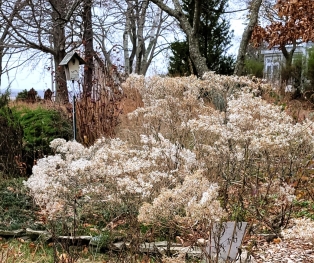
Summer’s bright flowers and wavy grasses are dry and grey in winter. Many would say they’re not worthy of reprieve from autumn clean-ups.
But there’s another perspective circulating among folks who offer ways to protect pollinators. The idea is called “Save the Stems,” calling upon gardeners and landscapers to leave dead-head flowers standing until spring.
Why?
"The uncut standing stalks resist mold and decomposition," says Sarah Foltz Jordan, senior pollinator conservation specialist at Xerces Society for Invertebrate Conservation. "The freshness of the stem cut seems to matter to bees [when they're scouting for egg-laying sites in spring]. If you cut in the spring, those stem entrances are cleaner." She continues, "In addition, some stem-nesters appear to be restricted to upright stems."
For details on “Save the Stems” see xerces.org/publications/fact-sheets/nesting-overwintering-habitat.
Landscape professional Petie Reed runs Perennial Harmony in East Lyme, CT. She says, "It can be a hard decision for my customers. They want their landscapes tidy, but they also want to help pollinators and birds." She says that some people are compromising by keep a strict standard in visible parts of their yards, while allowing leaf piles and deadhead flowers in less visible areas.
Other compromises are possible.
For instance, when selecting plants in the spring, look for perennials, grasses, shrubs, and trees that stand up well in winter weather. The options are more numerous than many people think. (See a list at the end of the Zip06 article.)
Nancy DuBrule-Clemente, founder of Natureworks, a garden center and landscaping firm in Northford, CT, observes, "I love the great coneflower in winter--it's so architectural. I also love the fluffy white seedpods of smooth blue aster. I leave them standing for the birds," she says.
Petie Reed calls little bluestem, green-headed coneflower, and mountain mint "sturdy winter plants" that stand up to wind, ice, and snow.
My own nominees include goldenrods, fairy candles (a.k.a. Culver's root), and New York ironweed (though it may need staking).
There are many more. See the list of flowers, grasses, trees, and shrubs at Zip06/TheDay.
